Introduction
Background of SABIC
SABIC is a Saudi based multinational petrochemical company holds the sixth position in global petrochemical market and it has large number of manufacturing plants in many countries of the world. According to the report of HSBC (2007), SABIC established as a non-oil company in 1976 by means of royal declaration along with the precise aim to accumulate value to the hydrocarbon wealth of Saudi Arabia, for example, byproducts of oil and gas, which has no direct utilization or market value, but left as waste. According to the annual report of SABIC, in 2009 this company earned about SR103bn sales revenue, which was less then previous income level. It has more than 33,000 staff who worked for the development of non-oil sector in Saudi Arabia. However, SABIC follows international expansion strategy and it starts business operation in more than 100 countries because the vision of SABIC is to become the world market leader in petrochemical industry.
SABIC maintains complicated organizational structure as it has different corporate division, separate departments for business operations and shared services. According to the annual report 2009 of SABIC, it has earned over 60% of total profit from single business sector though it has differentiation in its products offered to the clients, such as, basic petrochemical products, fertilizers, metals, plastics and so on.
Jaroudi (2007, p.54) pointed out that, this company was performing as the owner for its affiliates from the very beginning and it had no direct link with the management of the affiliates in case of business operation. This scenario changed from the fiscal year 2002 while SABIC modernized its affiliates in order to control and maintain the administration more efficiently. To coordinate the activities of the company, it separated the company in six major Strategic Business Units and established E&PM1 Departments in 2003. However, its share service unit consists of seven sub units and E&PM department combines four sub-departments.
Al-Jaroudi (2007) pointed out that the key purpose of SABIC formation had to utilizing natural gas as well as the crude oil. Alternatively, SABIC and it’s affiliates have aimed to fabricate, organizing, operating, selling and marketing of the petrochemicals, fertilizer production, iron, steel, and aluminum over and above supplementary hydrocarbon those have essentially needed for the development of the Saudi Arabia industries. Public and private ownership ratio of SABIC has respectively 70% and 30%. Moreover, SABIC has owned 22 petrochemical along with the metal complexes those have stayed in the Saudi Arabia, Asia and Europe. Among them four complexes have entirely owned by SABIC and the rest of have joint ventures with the local international investors like the Shell, the ExxonMobil.
Almubadal & Al-zahrani (2005) stated that the SSO2 adopted in the fiscal year 2003 in order to modernize SABIC uniform services in the area of SBUs and the corporations at optimal level. On the other hand, during 2003, SABIC has taken another revolutionary step by constructing the E&PM3. This department has also termed as Service Provider Corporation since it has assigned to enlarge and maintaining organizational structure, coordination as well as appraisal of keep continuing SABIC’s finest practices for supporting, executing all site capital projects and major affiliates who have also defined as internal SABIC consumers.
Research questions and Objectives of the study
- What is the best shared services design practice applied in the international petrochemical firms;
- What is SABIC design practice for petrochemical projects;
- How to measure the performance of Shared Services practice;
- How to improve engineering & project management practices in SABIC.
Significance of the Study
There are huge professional and academic studies on petrochemical industry as it is one of the most significant industries in the KSA and the demand of petrochemical is escalating dramatically, for instance, average growth in last five years was around 58%. However, SABIC is one of the global market leaders in this industry, which is committed to deal with large industrial projects to play imperative role for the development of Saudi economy. However, E&PM of SABIC has established in order to enlarge existing plants and to construct new ones in very effective manner to maximize the revenue of the projects. As a result, it is significant to conduct the research on enhanced shared services project management practices of SABIC
Limitations of the study
The researcher had suffered following problems to complete this dissertation –
- The main trouble was the low response rate because respondents were either busy with their own job or reluctant give response;
- The author of this dissertation got very short period to plan or conduct research;
- Many respondents sent his survey form after finishing the research;
- Budget was not enough to gather primary data from interview;
- Complex analysis of results and tendency of becoming biased;
- It was difficult for the researcher to find out relevant data as irrelevant or limited secondary resources were available on the design practice of Shared Services Engineering & Project Management of SABIC.
Scopes of the study
This dissertation has unlimited scopes in following area –
- The researcher of this thesis intend to conduct real research on the customer service of Engineering & Project Management department of SABIC;
- The entire study will assist to provide fruitful, realistic and applicable suggestions and recommendations to advance E&PM’s customers satisfaction;
- The service range of this department has advanced because of technological development, for instance, SABIC integrated SAP to continue relationship with customers. Therefore, this study has scope to contemplate on effectiveness of the software solutions in Project Management Practices for SABIC;
- Like other petrochemical industry, SABIC also faced huge losses for global financial crisis, as a result, this paper has vast scope to consider the development project of E&PM department in Jubail to recover the position of SABIC from recession;
- Finally, this research paper has opportunity to assess the effectiveness of E&PM on its affiliates.
Literature review
Introduction
The literature review of this Dissertation ‘Enhanced Shared Services Project Management Practices at Saudi Arabian Basic Industrial Corporation’ has been deliberated to resolve the research questions from the theoretical perspectives. It has concentrated on the best-shared services design practice applied in the international petrochemical firms, measuring the performance of shared services, design practice at SABIC petrochemical projects and its improvement of engineering, and project management practices. To enlighten on these areas, this literature review has presented the views of accredited scholars, researchers, and theoreticians worked with shared services design and practice.
Best Shared Service Practice
Wang (2007) identified shared service as the standardization and regulation of common tasks within the different department of an organization or across the numerous organizations to trim down the operational costs and to boost information and skills sharing rather than outsourcing. In the modern world, shared services have practiced broadly in both the public and private sectors considering as a substitute to outsourcing while the cross-organizational aspects of shared services generate unique characteristics in relation to other business entries. Aguirre et al (1998) pointed out that the integration of successful shared services aimed to maintaining a particular service quality with time saving manner for each service purchaser organization.
Generally, the shared service implication involved with information system service, public and private accounting and financial services, purposeful customer relationship management, skilled human resource management, engineering and project management and even selected lines of production as well as business.
Selden (2010) mentioned that as more and more organizations are connecting with shared services, it is generating increasing realization of the significance to put into practice of shared services as well as restructuring organizations while many organizations have exposed the necessity of substantial efforts to fit shared services appropriate with their exact situation.
The successful accomplishment of shared services necessitates a new organizational structure that drives every collaborating organization to shape a network of associates where the shared service providing company would locate at the nucleus. The shared service providing companies endow with shared services and exact knowledge for all partner firms and every individual company is the stakeholder of the service providing company as well as take action as a unique part of its governance. This type of strategic alliance facilitates with value adding, resource mobilization and knowledge sharing and risk sharing among the partnering organizations in the field of HR management, information system service, as well as accounting and financial aspects have demonstrated huge success of shared service (Audit Office NSW, 2004).
Characteristics of Best Shared Service Practice
Mechling (2004) argued that services for common functions in a corporate house could be shared within its different unite to diminish operational expenditure and to boost free flow of information along with proper knowledge sharing in the course of standardization and integration of enhanced shared service processes.
Davenport et al (2004) explained that to integrate shared services it is essentially required momentous transformation of business model to reducing cost by means of business practice re-engineering that is a strategic prospect of shared services through sharing most common, but non-core business activities those would radically progress the business performance of each unites who utilizes shared services.
KPMG (2008) stated that the best-shared services design and practice is thus concentrating on diminishing the costs of business progression and services development organizing a long-term strategic alliance with other organizations to share information, data, and knowledge and to set up leadership in the course of emphasizing on core business functions.
Best Shared Service Practice for Global Petrochemical Firms
Muras et al (2000) explained the boundaries and frequent fall of fuel price have created continuous pressures on the petroleum industry to cut the rising costs and to boost efficiencies at their own Operating Business Units and at the same time for their Shared Service providing organizations. The international petroleum firms are strongly emphasizing to bring effectiveness of their shared service practice and the key issue concerned here is to particularly address whether the shared service would be outsourced or in-house. Chima (2007) pointed out that the themes of shared services practice within the petroleum firms are to introduce joined services by the business units of the firms to reducing the overhead costs and effectively identifying the way out of dropping their organizational cost structures.
Hussain et al (2006) addressed that the shared services practice within the international petroleum firms exists a tool rooted in knowledge and information sharing and cost accounting principles those delivers a bright viewpoint of cost cutting, production process development, joint service management by service point agreements as well as outsourcing analysis by application of the tools of Activity Based Management4. ABM
Muras et al (2000) also added that the application of ABM Model starts with resources and elements taking into account of works to occur such as salaries & benefits, logistics, office space, transportation and information technology expenses where all resources have considered an activity. For most, the international petroleum firms there are huge unique activities associated with their operation, but the victorious ABM application would concentrate to the key activity level to keep away from redundant difficulties. While the activity has traced, then it would be cost out with Activity Based Costing5 and the ABC of ABM is adequate to assess the aspiration of the breakdown that generates accurate activity of profitability analysis for the decision making of appropriate shared services implication for petroleum firms.
Best Shared Service Delivery Models
NECE (2006) pointed out that the shared service delivery models are organized integrating with business norms and legal standard through IT application to delivering the share service offerings towards their consumers. All shared service delivery model has required diverse level of lead-times, investment procedures, execution strategies that results overall controlling, duties and responsibilities, risk possessions and reflected differently for implication. These dynamics have essentially part of administrative decision-making procedures and required to have appraisal as well as integrated at the beginning of the shared service delivery model.
The shared services delivery models would settle on the nature and reality of the affiliation by which the companies would come at a point for joint services and determine the way out to working mutually for effective outcomes and the selected model positively connected for long-term to carry out shared vision, further improvement, and future outsourcing strategy and planning. Alternatively, the shared service delivery model has designed employment procedures as well as implication modes such as employment terms and circumstances while the recent global business management has compelled for consulting aid as well as TUPE6 planning. In this section, a few shared service models has described, but individually any of them could not be fulfilled all requirements of the international petrochemicals firms, following are the shared service delivery models has narrated with their attributes –
- Public Sector Business Unit Model
- Public sector Arms Length Body Model
- Joint Venture with a private sector supplier Model
- Outsourcing service delivery framework Model
Public Sector Business Unit Model
The most easygoing preference for the shared service providers is to set up a separate branch of Business Unit along with the existing departments and the new units will next function rigorously to convey shared services to the entire customers within the current department of the organization as well as customers come from outside of the Department.

The merits of the business unit model have demonstrated proficiency to governing and managing the public sector services, undoubtedly faster implication option as well as low cost of execution this business unit model has not required to planning TUPE.
On the other hand, though this model has too simple characteristic and easy root to implication, but it has faced a lot of difficulties or disadvantages such as high dependency, low profit orientation, as well as lack of opportunities private entrepreneurial initiatives, narrow scope of development of services. Since the government accounting regulations have resisted high earning to reinvest, poor internal IT resources, low employee involvement to applying the TUPE, provide poor customer service and lack of external fund or investment accessibility for managing cash flows (IBM Corporation, 2006).
Public Sector Arms Length Body (ALB)
Under this model, the shared services would be carried out through the imitative of public sector with their own resources with any involvement of private sector providers and it would possibly advantageous to let the shared service contributor to perform its functions next to its ‘arm’s-length’ starting since the departmental sponsors as well as to the potential customers. Within the public body, the application of ALB model possibly will obtain the shape of the ‘Executive Agency’ or even as a ‘Trading Fund’ as we as an NDPB7 where the degree of self-control of the model has long extend (Schulman, 1999).
Consequently initiatives of this model has covered the areas of independent decision-making, open the door for the private sector providers, extend asset volumes, own staff employment scope, budgeting as well as decision making for financial supports while the key objective of the ALB model is to facilitate greater independency to the arms and length body.
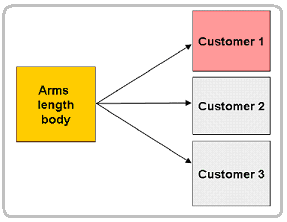
The advantages of the ALB shared service model is to provide greater scope to execute more accountability, responsibilities for CRM8 implementation by generating high efficiencies while the costs have more focused on the departmental units and avoid the TUPE planning because of low trade union challenges.
Besides advantages, demerits of the ALB model has pointed out as costly and time-consuming process rather than subsequent profit, poor private sector attachment, government accounting regulations follower and poor coordination between execution strategies and delivery procedure.
Joint Venture with private sector supplier: –
Typically, the joint venture entity has constructed through two or more parties for joint economic activities with the key intention to share skills and technological supports between public and private areas in wider regions including equity. This model is similar to the ALB, the joint venture model has also an individual vehicle for service delivery and it would form an equal stake as a result income, expense, and enterprise management operated through a proportion of shares of the participants.
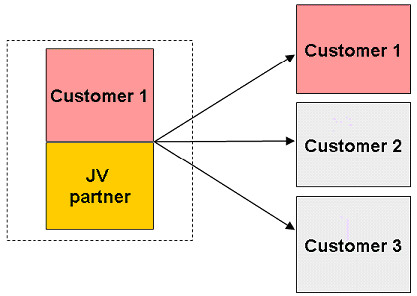
The beneficial points of the joint venture model has included potential consumer line, skill sharing, profit sharing, scope of future investment, assist the government sectors to gain and interchange align incentives.
At the same time the joint venture model required strapping project management skill to switch on, high risk involved to exit from the partner, the TUPE planning has produced anxiety to the staff, a lot of uncertainties existed against service demand, more cultural differences focused by the TUPE transfer and some other disadvantages.
Outsource through Framework Agreement
In case of shared services, delivery through outsourcing the framework agreement would be the most suitable model while under this model, the government body has performed as the CPB9 in order to collect service-purchasing contracts from the private sector suppliers. Additionally, the framework agreement model has facilitated to practice open procurement method where accomplishment of the contract does not necessarily require completing to be awarded the bid like other government bodies.

Roberts (2009) argued that the strengths of the framework agreement has discovered through efficient savings offers, which is unpredictable for the public sector service providers, but this model has the scope to transferring staff to the private department to ensure efficient savings. For the framework agreement, no further purchasing would be required during serving the new consumers, both cost and execution time would be saved by enjoy of greater economies of scale and supply of standardize services from the private department. Additionally, it provides consumer benefits as well as assessed the growth rate with appropriate volume of demand while the risk transferring support, consumer increase through price reduction, transparent and accountable shared values during building commercial relationship is other advantage of the model.
The framework agreement has included strong contract to management skill to bring success while the model provide inadequate duration for transformation and procurement would be hampered devoid of sufficient resources and skills. The framework agreement model is very sensitive to the political issues, and another limitation is that the public sector employees would not be wished to transfer in the private sector (Intellect UK, 2007).
Consideration for Model Selection
NECE (2006) argued that before selecting the shared service delivery model it is essential to identify the business necessities for which the services would employ and further consideration would be assessed with the following evaluating criteria of the models –
- The shared service delivery models would be chosen by applying decision-making properties those are generated by adopting the strategic questionnaire constructed one by one to decide on the ideal cooperation opportunities for all collaborating parties requirements while the favored involvement alternatives would border the weighted joint services delivery models due to the legislative concerns;
- To selecting the shared services model, the further consideration is to assess the setup and running costs though the cost is not any criterion, but to maximizing profitability, it is essential to reflect on affordability as well the Best Value within the selection process of the models. Other considerations for selection process of shared service delivery model has been demonstrated in the following diagram –
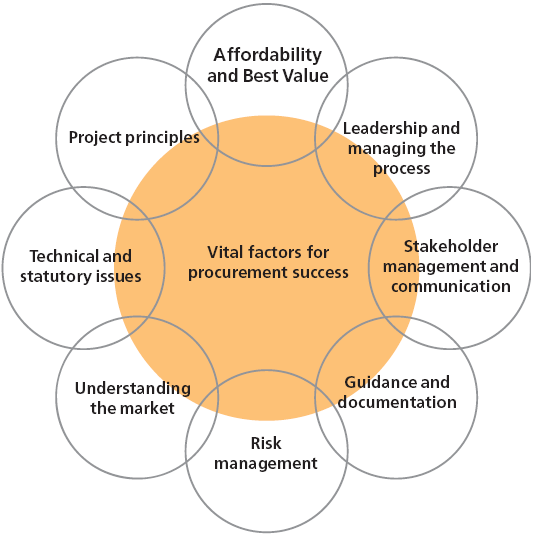
Design Practice for SABIC Petrochemical Projects
Duncan (1996) pointed out that organizational functionality involved two overlapping aspects such as operations and projects while both have common properties such as ‘done by people’, organized with limited resources’ as well as planned, implemented and controlled’ but they differs in the point while the operation is ongoing and recurring, the project is short-lived and unique. At the same time, projects are defined as temporary attempt carried out to produce some product or else services poles apart to extend away from all comparable products or services existing in the market.
Duncan (1996) and PMBOK (2000) identified nine major knowledge areas for successful project management, such as, Integration, Scope, Time, Project Cost, Quality, HR, Communications, Risk, and Procurement management are unavoidable concern of modern project implication with the course of action and necessary strategies for different procedures have been integrated the mentioned areas for successful practice.
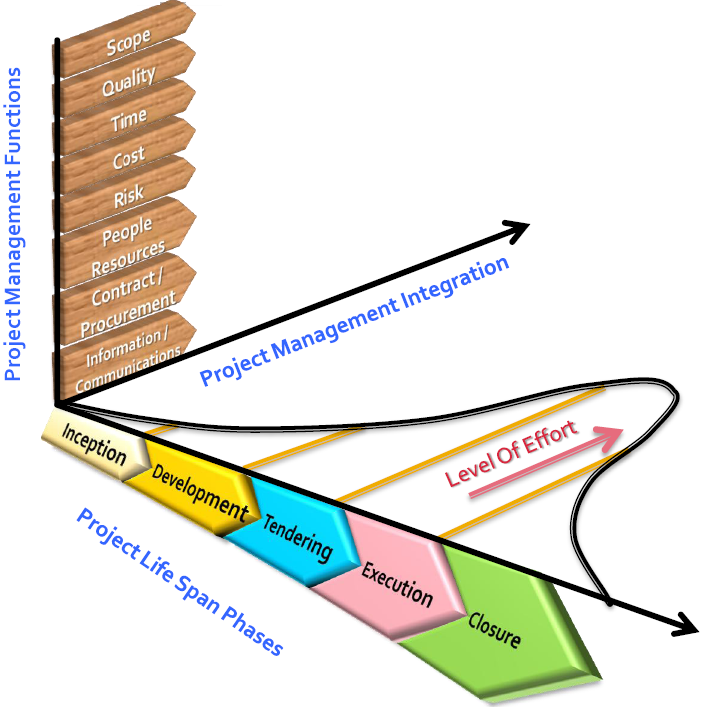
Duncan (1996) and ITC (2010) added that project integration process has six junctures those categorized as developing project charter, build up project management plan, directing and managing project implementation, monitor and control project working, carry out integrated change control, as well as closing up the project
Project management initiatives of SABIC at its E&PM has been originated fitting with the theoretical implication of project management guided by Project Management Institute and deliberated with high Integration, articulated Scope, ensuring proper Time management, regulating Cost management, guaranteed Quality management, intriguing with Human Resource, Communications, Risk, and Procurement management at its petrochemical shared service projects. E&PM at SABIC has plied the generally accepted project management knowledge and practice for its shared services implementation for engineering and project management department.
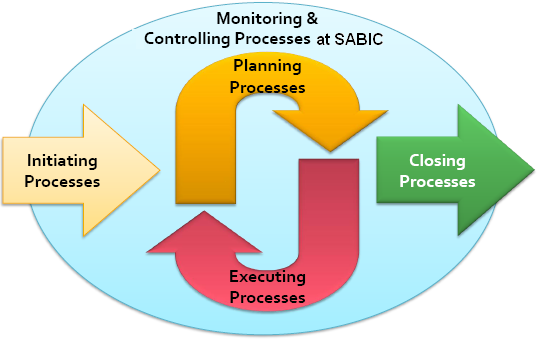
Almubadal & Al-Zahrani (2005) and Ramady (2006) pointed out that the project management process of SABIC has well thought-out with five sets of process, such as, initiating, planning, executing, controlling and closing and all that process sets are connected with each other in a progression where one of the outcome goes to next as an input to administer internal co-functioning.
Model of Design Practice at SABIC
From the theoretical perspective the shared service design practice of petrochemical projects at SABIC fall in the Public Sector ALB category that provides greater opportunity to execute more accountability, responsibilities for CRM10 implementation with high efficiencies while the costs have remarkably reduced on the departmental units. According to Al-Jaroudi (2007), for the petrochemical projects SABIC has practiced an assembled form of two design modules to execute all of the engineering procedures. They are termed as the fundamental design arrangement and the DDP11. The design package has composed of six major elements as below:
- Engineering drawing
- Calculation
- Technical arrangement
- Estimate cost of the project
- Schedule
- Project materials record
Alternatively, two common and mostly used design practice model of SABIC are listed below and thereafter a brief account of them has presented.
- FEEP12
- DDP13
Front End Engineering Package
The term FEEP has also denoted as FEED14, Front End Engineering Design practice at SABIC has initiated in 2005 with original conceptual framework of design to maintain the first trail program of project to assisting the clients to order placing for grievous long lead items such as compressors, extruder, and high pressure pining and so on. It has included basic design forces as described in below (Al-Jaroudi, 2007) –
- Relevant study materials
- Arrangement of substitute designs
- Sponsors
- Evaluation of costs
- Project implementation strategies
Al-Jaroudi (2007) also added that the Front End Engineering Design practice at SABIC has composed by consequent 11 stages as below –
i. General: general part of the FEEP has studied both the conceptual design packages and the potentiality of the project in practice. Here are the entire factors of this part-
- Abstract of the project
- Scope of work
- Relevant codes and standards of the project
- Duties and responsibilities
- Prerequisite protections
- Materials
- Execution strategies
- Cost evaluation
- Project tabling and calendaring
ii. Workflow: Ramady (2006) argued that the idea generation is the first of a project and encouraging dynamics of the project idea generation have involved in project volume, formation style, scope and other required features. Usually, a project architect has become an end user of the merits of the operating division. Additionally, the project architect has also required to developing CDP15 in order to make available support to describe the projects via engineering drawing and sketches. After preparing of the CDP workflow, the FEEP has moved forward to SPE16 for easier communication and the SPE has passed through the CDP as well as to the LPE17. Whilst the FEEP project team has completed 90% of the project, they have transferred it to the TAT18 to proofread so that the FEEP team would ensure whether the PHA19 or the HAZOP20 be required. Walk through all of these stages the FEEP workflow has achieved 100% FEEP approval (Ramady 2006).
iii. Scope of work: PMBOK (2000) pointed out that theoretically, scope of work has defined as the replacement of the existing parties by the newcomers and in case of petrochemical projects, five different engineering divisions have utilized to ensure the entrance of newcomers separately. Suppliers have delivered prime motivation to expand the scope of work practice and typically, they have discouraged to purchase existing products and services.
iv. Codes and standards of FEEP: Ramady (2006) explained that both the domestic and international organization, SABIC has required to adopt a set of ‘codes and standards’ so as to achieve organizations principles. More specifically, the term codes has presented a few specifications like analyzing, manufacturing as well as constructing and the term standards has involved in fabrication to gain consistency, competencies along with specified qualities. Mission of the FEEP codes has discovered through efficient performance, safety parameter at optimal level as well as high quality. Conversely, the missions of the FEEP standards have included inventory volume, size, and variety in design shapes and so on. In short, both the codes & standards have significant strategic role in completing an excellent project design. It has mentionable that though the SABIC E&PM created uniform codes & standards for their affiliates, but each of 18 affiliates have their own codes &standards.
v. Safety requirements: since petrochemical manufacturing and handling has needed health, hygiene, safety, as well as environmental concerns, safety requirement part of the SABIC FEEP has included the entire health, hygiene and safety issues. Alternatively, to assist the FEEP safety requirement, PHA & HAZOP would be utilized if necessary. Tasks of the HAZOP have to prevent and protect potential accidents through completing two stages. Typically, following are the team members of HAZOP.
- Affiliate operation team leader
- Secretary
- Site Project Engineer21
- Process Engineer
- Control & fabrication engineer
- Safety Engineer
- Operation specialists
vi. Materials: Al-Jaroudi (2007) mentioned that the FEEP of SABIC has two categories of materials the MTO22 and the long-lasting items. Usually, the MTO records have supplied by the contractor of the construction project. Most of them has shelve-material abundance in market and do not need to order specially. Furthermore, a purchaser could be collected them within four (4) to six (6) weeks. The long-lasting items have required special order before deliver to the purchaser and have taken six (6) months to one (1) year to delivering. Typically, the long-lasting items have manufactured in European and American countries.
vii. Execution strategies: execution strategy of the FEEP has directed by assembling two dynamics the project feature and the entire resources of SABIC. In case of licensed as well as patent project, the contractor would have responsible for the EPC23. For example, lump Sum Turn Key24 project execution strategies of SABIC has presented in following table.
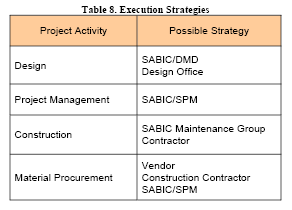
viii. Cost evaluation: usually, cost evaluation of the FEEP has regularized that three (3) constructors along with three (3) vendors could be applied for budgetary quotation. After finalization of the scope of work, design engineer has taken necessary initiatives for approval of the applied budgetary quotations. Design engineers of different disciplines would be responsible for their own discipline individually.
ix. Planning and Scheduling – SEPs have categorized into two forms the shutdown projects and the normal projects. In the FEEP planning and scheduling, project duration has significantly fluctuated because of the materials delivery time. For example, SABIC shutdown projects have required occurring two times during a year one in May and other in November. Planning and scheduling of the FEEP has documented by utilizing simple Gant-Chart, scheduling software.
x. Drawings: drawings of the FEEP have mostly composed on conceptual design to generate concept of the project. Typically, the FEEP drawings have attached through P&ID25, PFD26, blueprint of the new proposal, arrangement of the equipment, plot plan, etc. Alternatively, affiliates of SABIC have made available scope of the EDMS27 service through which external consumers could be easily searched drawings documents.
xi. Responsibilities: predefined roles, regulations, and responsibilities of the FEEP have enlisted below –
- Design Management Department28
- Site Project Management Department29
- Affiliate Departments
- Safety and quality controlling or quality assuring (QA/QC)
- Vendor: vendor has involved in supply of materials, approval of the engineering documents, ensure better performance and so on.
- Contractor of the construction: These vendors would involve in the project execution according to the design package and supply of material according to MTOs ensuring the codes and standards of SABIC.
Detail Design Package
The DDP has worked through utilizing seven consequential stages descried as below. (Al-Jaroudi, 2007)
- General: in an investigation, it has evaluated that entirely all of SABIC projects have followed DD30. Alternatively, mass area of the SABIC petrochemical processing has constructed through the EPC and the contractors have liable for all responsibilities of the DD. In broader form, the DD documents have categorized into two forms like the technical document and the contracting documents. On the other hand, in case of EP project, DD, fabrication, assembling, supply of required equipment has arranged via vendor. Additionally, it has to be reviewed as well as approval of vendor, DD according to regulation of the DMD. Otherwise, the usual projects either has prepared by the DD or by the DMD since there have limited scope of vendor. The SMO31 has supplied the entire contracting documents including general circumstances, special conditions along with the design of contract.
- Workflow: Workflow of the DEP has continued a flow among DMD, TAT, and SPM. After completion of 90% DEP the TAT has checked, approved and forward towards the SPM and its affiliates promoters to review the project. At the end of reviewing, the SPM has sent back the project to the DMD with comments if required while the DMD has finalized the construction issues and transferred to the SPM to executing after bidding processes Ramady (2006).
- Document catalog: the document catalog of the DEP has assigned to recording of entire deliverable, common scope of work, and the DD documents for every discipline. In this recording process document type, volume, heading, sheets number, percentage of progress has controlled under the DD method (Al-Jaroudi 2007).
- Scope of work: the DEP scope of work has applied for contracting purposes as well as the external utilization. Alternatively, the DEP scope of work package has highlighted and responsibilities of the individual department duties like vendor, contractor, DMD, SPM along with its affiliates. For example, vendor has assigned to supplying centrifugal pump, constructors have to installing the pump and so on.
- Detail drawings: compare to the FEEP the DD drawings have more elaborated and transformed current drawings for reviewing via the DMD. In this case, vendor has composed new drawings to facilitating new entrance has said by SABIC drafting standards.
- Technical requisitions: technical requisitions of the DEP have drafted during FEEP, but utilized at this point. If new requirements have needed to enlist previously drafted, the technical requisitions have to revise consistent with the most recent requirements.
- MTOs: MTO the last stage of the DEP has required to billing entire materials according to DD drawings so that correct cost evaluation with 5% accuracy would have achievable and successfully utilized in the PMM32 (Al-Jaroudi 2007).
Determinant of the performance of Shared Services practice
SAP AG (2004) pointed out that the Customer service is the sole determining factor to measure performance of shared services practice of an organization, thus it is essential to maintain an effective system to monitoring and assessing the performance shared services. Wang (2007) added that the performance of shared services does not only indicate to delivering the service, at the same time also ensuring delivering the service on time with promised qualities and quantities to bring the customer’s full satisfaction.
Most of the modern organizations make use of at least an essential degree of performance measurement while from the financial consideration management frequently assess how the organization and its departments tie up with the budgeted factors. This is a very simple process to determine the performance status of an organization within a suitable condition. On the other hand, some organizations take comparison measures of in-house performance by means of a benchmark of similar organization while the benchmarking is a recommended come out for the organization that follows independent business model for its shared services practice.
Beaman (2008) pointed out that the advanced performance determination would apply non-financial measures such as KPIs 33 to evaluate the performance while the non-financial indicators involved with customer’s satisfaction, free flow of information, intensity of expert knowledge sharing within the members of the group as well as average lead-time to processing any transaction. The non-financial indicating factors always assist to identifying information connecting to the promising future performance of shared services while the financial measures are enough advanced indicator to demonstrate the results that the organization achieved within a particular timeframe.
The Management theoreticians have suggested the shared service centers to apply different methodologies to measuring their performance such as balanced scorecard perception has gained most popularity in this regards. In this process, balanced scorecards could prearrange with hierarchies to put forward all management intensity within the company with the accurate information and even more adopt innovative approach to using the scorecard as a strategic communication standard to accomplish appropriate corporate strategy for shared services practice.
Single & Multi server service Performance
Balsamo & Marzolla (2005) addressed that multi product structure of queuing network models have all over application to measuring the performance assessment of shared services practice and the models have the capabilities to providing perfect forecasting of service levels of resource sharing method by using computer systems along with communication networks.
According to Wang (2007), assortment of the service centers would be represented by means of the queuing network models in order to provide services towards the collection of consumers who have represented farm duties and characterized the system resources. Bolch et al (2006) identified that the corresponding consumers would be queued within the service centers whilst the large number of customers rivalry compete to connect the service of resources, whenever a consumer has served via service centers he may depart from there immediately and join into the queuing network of the additional service. John (2007) added that in case of the multi-class product or the extensive product line, queuing network consumer classes have required to correspond for multiple requirements along with diverse circumstances. In addition, the queuing network models associated with multi product assortments possibly generate infinity of entire queues to the probable service centers and would belong towards any one of the following four categories:
- FIFO34 Scheduling: The FIFO scheduling has featured with the distribution of service time, identification of every consumer class in case of the singular entry server service centers with arrival priority basis,
- PS35 Scheduling: the singular entry server service centers have followed this module to allocate service time for the uninformed consumer by process sharing according to customer category;
- LIFO36 Scheduling: the LIFO has worked for the uninformed consumer by means of the preemption scheduling along with allocation of service time,
- Infinity Entry: Both the uninformed consumer and infinity-server service centers have involved for allocating required service time.
In the aforementioned four categories, earliest three have only single entry server to serving the consumers and thus the consumers have needed to waiting in the queue before they have served, but in the last category, there are infinity entry server to serve multiple consumers at a time and they would be served promptly on their arrival. It has to quote that for the fourth module there is no need of any queuing to get service as the service centers have numerous computer labs with scores of computers to serving a large number of customers.
Again, Balsamo & Marzolla (2005) stated that queuing network models for the multi categories of products have proficient arrangement to provide truly acceptable illustration for numerous authentic systems by utilization of bulky as well as further complex multi product queuing networks could be exactly estimated for few non-product appearance queuing networks. For an accurate model of shared service, it has enough to scope to apply the multi product queuing networks model to form of appraisal at diverse partner companies that has same types of consumers queuing networks. As a result, suppliers of the joint service resources have modeled similar to the service centers existed at queuing networks and in practice, every farm task or customers service requirement would be executed and keep in touch towards the infinite queuing capacities for every queues presented in the networks in due time.
Illustration of queuing network model
To illustrate queuing network model, Wang (2007) has assumed that a shared service provider has two employees A and B who are engaged to perform accounting and auditing activities respectively for the diverse companies named X and Y with dissimilar requirements of services. Amongst the companies ‘X’ has two categories of services requirement while for first duty required an individual employee ‘A’ in order to execute accounting needs and on the other side, their second requirement has needed ‘B’ for auditing activities. Another company ‘Y’ has just a single service requirement for auditing by ‘B’. Wang (2007) has presented this shared service model through the multi category product queuing network where the provider has three consumer groups along with two single entry server service centers; here is the queuing network model stands as-
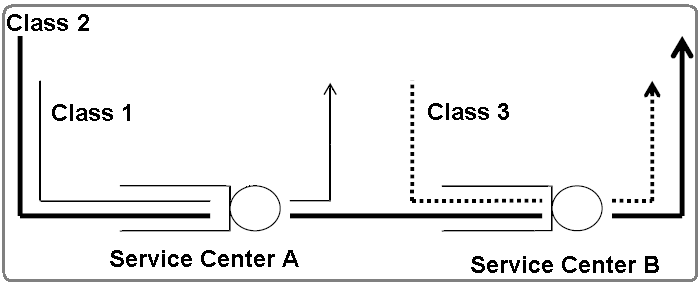
Suri et al (2007) reported that typically, performance evaluation of the multi category product queuing networks model could be assessed through the MVA37 algorithm though they contained large number of data as well as longer computational requirements to generate fairly accurate volume networks and to obtain standardization of constant values. Bolch et al (2006) pointed out that the MVA has the efficiency to prevail over difficulties during longer computational requirements for critical situation, and in case of complication, numerical complexities have grown whenever the network has composed of greater quantity of stations along with wider consumer category. John (2007) argued that, if the utilized model would not supported to provide itself for the heuristic expansions in favor of additional general system model, the MVA has prospect to avoid described complexities as a result, it has mostly used as performance measurement technique. Conversely, accumulated necessities for which demand of MVA utilization has increased on behalf of multiple service center networks, numerous divisions of the consumers, individual consumers group for more clarification, if any network has composed of multiple entry server stations, the key evaluation has required to assess marginal potentialities besides the MVs38. As a result, assessed results have more complex than before as well as further crisis of requirements have increased. Here is the list of parameters of the performance measures of shared services and the model development notations are as –
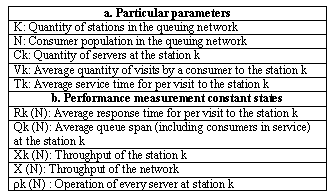
Equation-1: in accordance with the arrival theorem, the average response time for each visit of customer in the single entry server station has expressed through following equation where number of arriving consumer has assessed via Qk (N −1) and the algorithm stands as-
![]()
Equation-2: If k facilitates with multiple servers, then the inward customer will get a number of customers in service and some of them are waiting, customers of the multiple servers posting would affect in multiple enduring service times and average response time for each visit multiple server station. It has expressed through the equation as below that has affiliated with the AMVA39 algorithm additionally, here the surveyor has required considering an adjustment dynamic Yk to decrease consumer waiting time complexities-
![]()
Equation-3: third equation deal with the reflection of the multiple servers at the station, k considering additional two forces of single entry service time, Tk and condensed interfering time, YkTk utilizing the SB40 approximation, the equation stands as –

Equation-4&5: X (N) the network throughput as well as the average queue span, Qk (N) has conveyed below –

![]()
Equation- 6: replacing the constant factor X (N) of the equation-4 and revising the above equation-5, the equation-6 would be reflected non-liner correlation of k in terms of Qk (N) as follows –

Equation-7: through utilization of the elementary queuing theorem, local station parameters, Yk would be hypothesized only by two parameters Ck and ρk those have represented quantity of the servers and operation at every server respectively at the station, k, under this course of action, equation-7 has structured as follow –
![]()
Challenges of Performance Measurement
Schulz (2009) pointed out that the challenges of measuring performance are enough technological than its business process as the modern management is familiar to weigh up the performance of their employees without bothering whether they are within the organization or in any other unite of shared service providers.
Some companies utilize budgets as a tool to identifying and evaluating the performance of employees and the employees are mainly weighing up in accordance to meet the targeted financial standards while the other companies use non-financial indicators like application of balanced scorecard. Thus, it grounds severe confusion among the workforce as they evaluated with two tools, but only the financial indicators have direct persuade on their remuneration while Balanced Scorecard and ‘KPIs’ results only good reparation, but never rewarded financially.
To remove this confusion, it is essential to make it clear whether financial indicators of budget would evaluate employees or achieving the standard of KPIs contained by the Balanced Scorecard while the financial indicators are absolute nature, the Balanced Scorecards are as a rule of relative in nature. It would be extra burden for the employees to face two performance measurement tools and at the same time both application may not bring satisfactory results. However, the corporate houses still prefer to uses budgets, but as an independent contractor, the shared service providers have the opportunity to practice both process to bring more integrity among its employees.
Possible IT Solutions
SAP AG (2004) suggested that the perfect approach to remove the dilemmas of performance measurement is to strongly tie-up the setting process of shared service practice with the performance measurement procedure where the numbers of selected indicators, ranking of management levels, shape, and size of the service provider are foremost factors for decision making regarding appropriate functional support.
Improving E&PM Practice at SABIC
The E&PM has played as a consulting body, which has required making available technical assistance along with PMS41 toward the existing internal consumers or affiliates of SABIC. E&PM performance measurement has investigated and assessed the satisfaction scale of entire SABIC organizations that have treated as consumer while the E&PM has delivered services to them.
The E&PM performance standard investigation procedure has executed by means of a survey where a few selected consumers have answered prearranged questionnaire. Experienced and skilled engineers of the E&PM department have studied the undocumented feedback by the consumers before they have constructed the survey questionnaire. Factors of the questionnaire have included requested services, proposed delivery services, skills, and attitudes, after sale service along with problem solving assurance. Among these factors, the problem solving assurance has denoted the least force by the existing consumers. Alternatively, consumer performance scale has significantly fluctuated from 70% to 98%. Top-level engineers of the SABIC E&PM have wished to simplify the current survey program along with a wider range than now since the consumers have recommended a precise form of the satisfaction scale assessment (Almubadal & Al-zahrani, 2005).
Measures of E&PM Improvement at SABIC
According to Almubadal & Al-zahrani (2005), following are the major influencing dynamics of improving the E&PM at SABIC:
- Both staffing and de-staffing have minimized during execution of projects since SABIC has a significant impact on their affiliates;
- A uniformed package has applied in terms of processing, organism, and standard evolution, for example, standard ITB42 formats, contract assessment method, awarding and so on;
- Safer and hygienic environmental practices by the SABIC E&PM have given superior status to their site projects, such as, reliable safety application, health and hygiene, environmental appraisal, and recycling;
- Uniformed package has significantly reduced production costs as well as capital costs. For instance in case of medium size project, it has appraised that application of the uniform model can reduce approximately 10% capital cost of SABIC.
Departments of E&PM where Improvement Needed
Following are the four principal departments of the E &PM where it is necessary to address immediate improvement and reformation –
- Engineering: this department has primarily required to assisting all of the E&PM tasks such as safer and superior electrical service, control of processing, machinery maintaining, and civil, process engineering and so on. Moreover, the engineering department has to be discipline and skilled to meet consumers’ demand at an optimal level. Alternatively, the E&PM engineers have to concern on delivering recent organizational code of conducts as well as regulations to the external agencies and to entire employees for the skill development and implementation (Almubadal & Al-zahrani, 2005).
- Site project: in order to provide optimal scale of proficiency and safety during planning and execution of the site projects four dynamic have needed such as health and hygiene, cost management, scheduling and quality assurance. On the other hand, certainty of these competencies like quality standard would have appraised throughout an inspection.
- Project Management: taking into account an accurate project monetary accounting along with amendment form of project orders SABIC target project has governed. To assist both the project funds development as well as its execution SABIC PM has required high efficient costing model with project planning. Cost management and scheduling have controlled through an approved financial support and lead-time or deadline. According to the predefined project quality standards SABIC has arranged its project execution inspection so that the PMM has easily evaluated efficiency of the four dynamics of the site management.
- Design: design section of SABIC E&PM has worked to ensuring predetermined standards for the target project packages including safer electrical support, process controlling, supply of machines, detail civil engineering design and so on. In this case, project execution would be perfect if the project drawings have portrayed and supplied through a proper manner.
A detail account of the SABIC E&PM has plotted in following diagram where the improvement would be addressed –
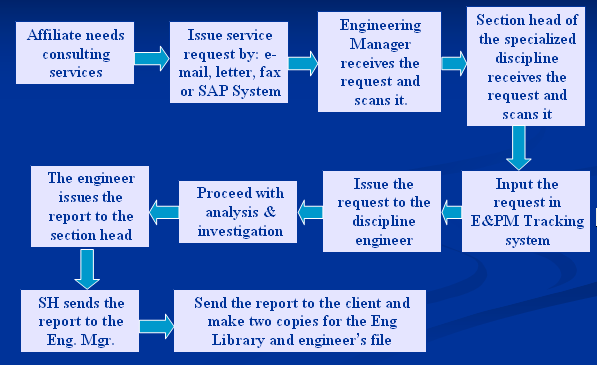
E&PM Improvement Objectives at SABIC
Entire command of the E&PM division of SABIC has established to continuously robust the process efficiency, mechanical support, civil engineering, safer electrical support, entire resource management, competency along with the desired engineering services. The E&PM improvement functions have responsible to acquisition development procedures, state the application procedures in accordance with the process engineering art and science, control of engineering tools, procedures, practice of the engineering standards, and state narrative form of the project guidelines etc. Following are the improvement objectives of the E&PM at SABIC –
- Technical services: The technical services of E&PM have taken instructive rules during acquisition both the development and application of the PM reproduction, flow chats, equipment management program, application of the accurate model in development, design guidelines for the discipline engineering, apply in the business units of SABIC. Additionally, this function has highlighted the plant engineering to conduct, investigation of the plants, plant upgrading, anti bottle necking studies and so on (Almubadal & Al-zahrani, 2005).
- Engineering standards: The tasks of SABIC engineering standards have assigned to mentor both development and execution of the engineering standards. Alternatively, the SABIC engineering standards have also directed to facilitate training support to the entire technical staff, so that they would be able to receive responses from the SABIC end-users.
- Project Support: project support improvements have included project team support to facilitate the center point of engineering functions like development and execution, project design revision as well as assessment if required, supply of essential contribution to the SBUs, conceptual development for the entire affiliates, and attractive packages to design process etc. In addition, in the area of principle engineering design package SABIC project support has assisted for the development of the in-house technology.
- Training Support: focused on the entire resources of SABIC, training support has processed to assist the discipline engineering economically. As a result, in the future, they would be able to share their efficiencies with different groups and departments of SABIC E&PM. Additionally, this improvement function could be played stewardship role through which SABIC could be able to efficiently communicate with its affiliates, establish, and continue professional progress for the engineering personnel (Almubadal & Al-zahrani, 2005).
E&PM Improvement Objectives at SABIC
Taking all of the aforementioned discussion into account following are the precise form of SABIC E&PM improvement procedure-
- In times of transition, failure would be avoided or prevented if entire SAP43 business process issues have resolved,
- Improvement of the service quality has required superior transformation for diverse E&PM models as well as processes,
- Technical expertise would be enriched by recruiting experienced project engineers;
- For committed services from the employees of contractors SABIC could be started to award annual bonus at the end of fiscal year, gift vouchers and so on. Here it has to be quoted that service provided by the contractor’s employees had a great sharing;
- Without end user’s satisfaction, SABIC services could not be highlighted in the international market and consequence of this, they have to provide durable and superior valued engineering services;
- For the requested service, process would have simplified and error free,
- For an economical service, SABIC E&PM have to be greater familiarized than now to the end-users to consider nature of services delivered by the engineering department. In this case, both the supplier and receiver have equally prioritized to get benefits,
- Diverse plants of SABIC have needed large number of engineers for more rapidly execution along with superior services;
- Intra-communication would be developed through monthly in-house conference as a result it would be strengthen family bonding of SABIC;
- The E&PM performance strengths mostly depend on the contract employees as a result during performance measurement as well as quality and service assurance these employees have required to consider as a significant factor or dynamic;
- Behind admirable services, the end users’ support as well as cooperation has needed to consider significantly;
- For planning and execution of required service the consumers of SABIC has to consider flexible lead-time during the order placement.
Research methodology
Research Method
The researcher of this dissertation will formulate the paper considering Malhotra’s six major steps for marketing research approach instead of Yin’s case study method. It is important to mention that the researcher will follow six steps because Stake and Yin (2002, p.5-6) mentioned that if research questions focus mainly on “what” or “How” question, then case study approach would not be an advantageous strategy. Here, research question number one and two was started with “what”. The researcher will design a questionnaire considering the topic and research problem, collect data from the target respondents, remove all errors from survey reports, and discuss the outcomes with recommendation.
Research Approach
Saunders, Thornhill & Lewis (2006) and Malhotra (2009) stated qualitative and quantitative are main approaches to formulate any research. At this point, it is significant to notify that the researcher will adopt both research approaches. They further added that quantitative research is significant to gather primary data through interview. In this case, the researcher will use both methods to get appropriate result of the questions, but the author will design entire paper by giving more attention on quantitative method. According to the view of Saunders, Thornhill & Lewis (2006), quantitative research gives the basic understanding of the words of public, perceptions, and values to resolve the research dilemma. As a result, the researcher will follow traditional face-to-face interview, telephone or e-mail method to collect primary data for evaluation the effectiveness of Shared Services Engineering & Project Management of SABIC.
Importance to apply descriptive research method
Some of the members of six affiliates of SABIC want to say their problem with suggestion regarding shared service of E&PM. Therefore, the researcher deliberate the questions based on both hypothetical and objective view, for instance, interviewees have to answer twenty objective questions while there should have option to share their experience with their valuable recommendation.
Primary research – Research Strategy
Malhotra (2009, p.103) and Yin (2003) expressed that the primary data originated for the particular reason or solve the research dilemma by applying major six steps. Marshall and Rossman (1999) also pointed out the difference between primary and secondary data sources by arguing that data collection from interview is a time-consuming and expensive issue. Malhotra (2009, p.151) stated that the focus group should consist of 8- 12 people. In this case, the researcher will gather primary data from the focus group and selected project engineers from six different SABIC affiliates are the potential focus group here. The author of this paper will design a questionnaire and select appropriate interviewing methods in order to collect primary data from the selected engineers or affiliates staff. However, the engineers and other personnel will be competent for interview if he has long experience to work in SABIC or deal with E&PM for their projects. It is important to mention that the researcher will use Microsoft Excel in order to generate diagrams from collected data from the affiliates of SABIC.
Table 2: – Target affiliates of SABIC in Jubail Source: Self generated
Selection of Interview process
Few respondents would like to give their opinion instantly if they have free time or have no important project for completion. However, the researcher will conduct face-to-face interview by applying following procedure:
- At first, the researcher will introduce himself with the affiliate member of SABIC and request them to answer general introductory questions regarding the interviewee (Section A of the questionnaire includes common question).
- After introducing with participant, the researcher will proceed on fundamental problems, which also address in Section B in the questionnaire;
- In this stage, the researcher will request the respondent to fill up the questionnaire to assess design practice at SABIC presented by Shared Services E&PM in Jubail
The researcher has selected six affiliates of SABIC in Jubail industrial area to contact directly with affiliate’s member, but for most of the respondents, it will be difficult to give feedback at once. In this paper, the researcher will apply other communication system in order to obtain feedback from the affiliate’s member of SABIC, such as :
- Telephone: Firstly, the author will use traditional phone or CATI system44,
- Mail: Secondly, the writer will consider usual mail, and email survey methods
Data Analysis process
After collecting the data from target respondents, the researcher will check all the survey report once more time in order to remove the irrelevant and inappropriate information from the paper. The researcher would refine left primary data regarding the satisfaction level of shared services project management practices to evaluate and compare with previous driven similar research. After careful consideration of the results of the survey, the author will compare and contrast the data of affiliate satisfaction by presenting graphical charts.
Secondary data
The researcher of this dissertation will use secondary sources for literature review as well as discussion chapter. Saunders, Thornhill & Lewis (2006) pointed out that secondary data mean processed data for existing purpose. Sekaran (2006) and Zikmund (2006) described the advantages of secondary data sources for research. However, the intention of the researcher is to analyze the topic with clear theoretical perspective to organize the problems, prepare a suitable research design, and answer precise research questions. Moreover, the researcher of this dissertation believes that secondary data would assist him to interpret primary data more correctly. According to the view of Malhotra (2009), it is simple to gather these data more quickly and inexpensively. However, the researcher will use the information from published books of renowned writers, research papers, project management case studies, journals, project management books, relevant research, or available survey reports. In addition, the researcher will take data from annual reports, financial reports, affiliates information, and other published document on SABIC or E &PM.
Questionnaire Design
Questionnaire designing is an essential part to reach proper conclusion and give suitable recommendations for the development of share service of SABIC. However, the writer has prepared a questionnaire for target respondents considering research objectives, busy schedule of respondents, recommended major steps of other renowned researchers, and data collection technique. The researcher emphasized the simple, small and straight – forward questions because there is no exact formula to design a questionnaire. Malthotra (2009, p. 281) pointed out that general discussion with target respondents would bring unjust result whereas specific questions help to avoid most of the unintentional mistakes. For this dissertation, the author will determine the content of questions, revise these questions, and reproduce the questionnaire structure very carefully to motivate, reinforce, and inspire the respondents to complete the interview. However, figure no one shows the questionnaire design procedure for this research paper –
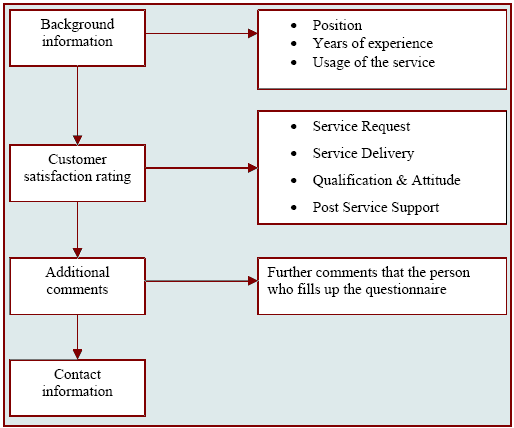
The first part of the questionnaire is concerned about the personal background of the respondents and the second part is concern on the research objectives, such as customer satisfaction issues, shared services, design practices, development of E&PM and so on.
Measurement and scaling process
- Nominal scales: This type of measurement system indicates non-numerical questions, for example, Name of the respondents or Nationality of the affiliate’s member of SABIC;
- Ordinal scales: This sort of measurement method point out questions in order and measure relative attitudes of the respondents;
- Multiple Choice – Single Response: In this case, respondents will get several options, but they have to select only one option;
- Likert scale: The research will consider this scale to measure the performance satisfaction rate. As a result, the researcher has designed Section C of the questionnaire in light of this scale as it consists of statements that express either a favorable or unfavorable attitude towards the object of interest:
- Strongly Agree = 1
- Agree = 2
- Neutral = 3
- Disagree = 4
- Strongly Disagree = 5
Table 3: Measurement stage with Scale Types in Questionnaire Source: Self generated
Limitation of Data Collection Process
The clients of E&PM are too cooperative to formulate the research, but the respondent have some corporate social responsibility and technical limitation to disclose the information about the shared service of this department. Moreover, they are not aware about the deadline issue of the researcher, so, most of the respondents give their feedback after reaching conclusion. Consequently, the author has to rely on some secondary data sources in order to get proper outcomes.
Data analysis and results
The cardinal issue of data analysis chapter is to discuss the results of the real survey to estimate and evaluate the design practice at SABIC presented by Shared Services E&PM in Jubail.
Section A: About Respondents –
Name of respondents
It was a general question important to introduce with the respondent of the survey
Grouping Respondents by nationality
It has already mentioned that engineers and staff of affiliates of SABIC in Jubail will be competent for the interview. However, the research of this paper has considered four members from each affiliate for this dissertation. The survey reports divide 30 respondents by their nationality and data find outs that 50% of respondents are Saudi citizen and rest of them are come from other countries. However, the author believes that the data from the member of different ethnic background would relevant to know others response.
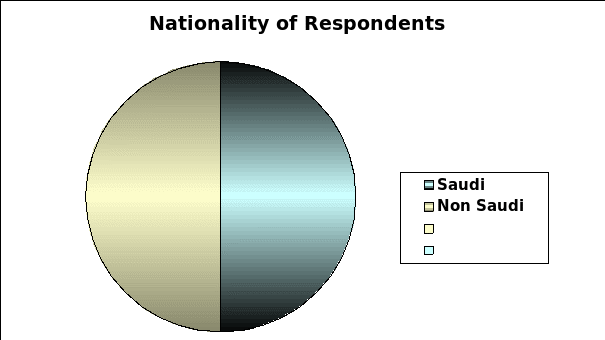
Grouping Respondents by educational qualification
The purpose of the question is to gather idea about the qualification level of the respondents as this questionnaire provides the option to give their comments about shared service of E&PM departments. According to the data sheet, it can assume that they are enough competent to give expert opinion because more than 80% respondents have passed university level or hold PhD from renowned engineering or other universities. The following figure shows that 85% customers have postgraduate degree and 15% respondents have PhD and other degrees.
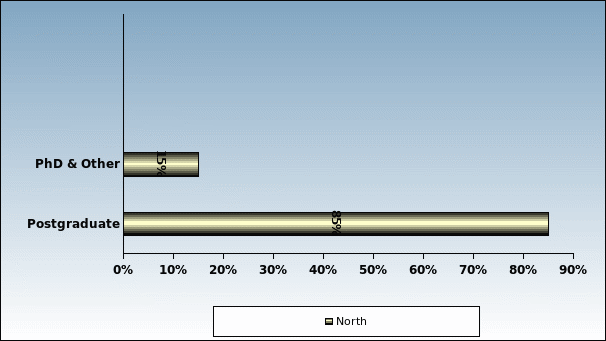
However, it was a general question, but this question was significance to assess the quality of the respondents because the findings and results of the dissertation would be based on the view of surveyors.
Grouping Respondents by job position
As SABIC is the market leader of petrochemical industry, it is essential for SABIC to have a clear idea about the opinion of senior executives. The researcher has chosen high officials or engineers from different sectors to interview, as management of SABIC should identify the drawbacks from reliable source in order to improve their share service range by relying on the survey results. However, the survey report shows that 30% of total respondents are project engineers, 25% respondents are design engineers, 20% participants are specialist engineers, and 20% customers are involved with other job.
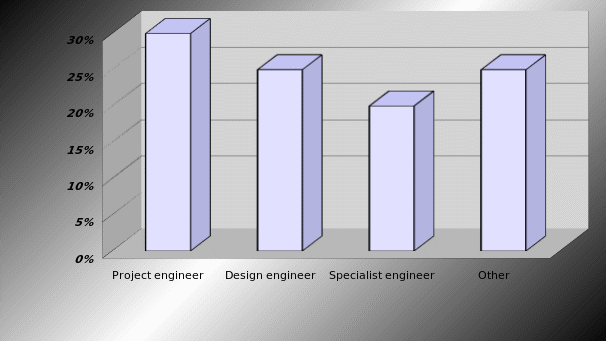
Most of the respondents are responsible for planning, contracting, safety, maintenance, operation, and design department.
Respondents considering experience
This question divides the respondents in three groups, such as, under 5 years, between 5 and 10 years and more than fifteen years. This is an important question of section A because this question helps to assess the potential customer of SABIC who would have the capacity to provide solution to the problem regarding design practice or shared service of E&PM of SABIC. According to the primary data, the majority of the respondents have more than five years experience, few of them have a long time working experience and rest of them have less than five years experience.
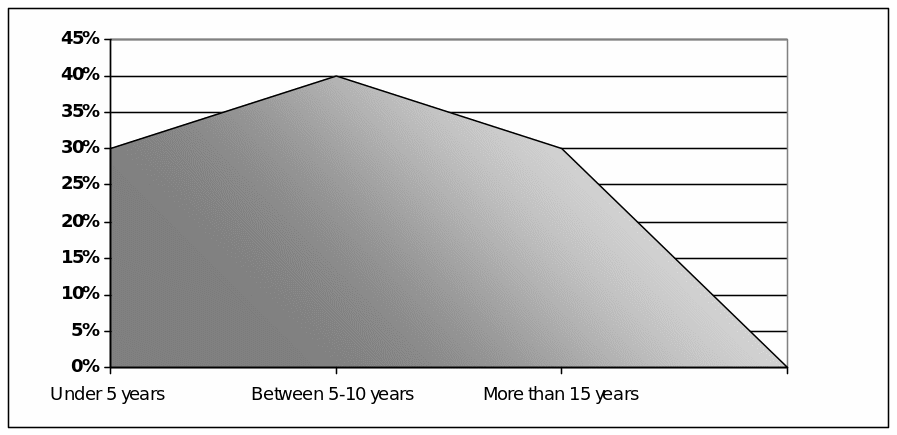
Result: Apparently, this is one of the general questions in questionnaire, but it has significance to measure performance satisfaction by experience. From the result, it can conclude that junior employees are more satisfied with the share service whereas most of the case senior members are unsatisfied with existing services.
Whether respondent asked service or not
The researcher of this dissertation has designed this simple question in order to assess the working pressure of E&PM of SABIC. Out of the 30 respondents of six affiliates, 29 respondents said they request for shared service of SABIC E&PM and only one customer never asked service directly.
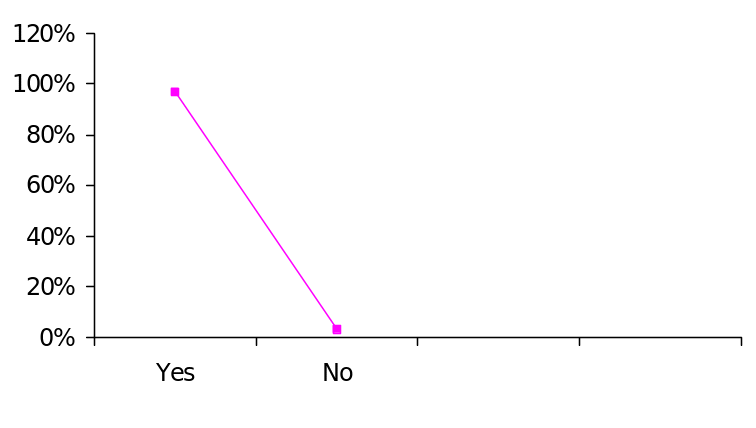
Do you have any complain against the service of E&PM
From the feedback of this question, researcher of this dissertation finds that 30% respondents confidently said that E&PM of SABIC provides very prompt or prompt services. On the other hand, 70% respondents selected that E&PM of SABIC gives feedback in very late or late.

Result: the answer of this question helps the researcher get an idea about the performance satisfaction rate. In addition, the above graph shows that most of the respondents were not satisfied with its shared service
Which method do you apply for sending your request
Most of the respondents selected Sap system and email option. The following figure shows that about 40% selected option (d) and 30% chosen option 30%. On the other hand, 20% of total respondents selected email option and only 10% used letter option

Result: the respondents can use any method to request service from E&PM and SAP system is most effective method for this purpose.
Respondents view about quickness of service delivery
From the feedback of this question, researcher of this dissertation finds that 30% respondents confidently said that E&PM of SABIC provides very prompt or prompt services. On the other hand, majority portion of the respondents has chosen either late or very late option
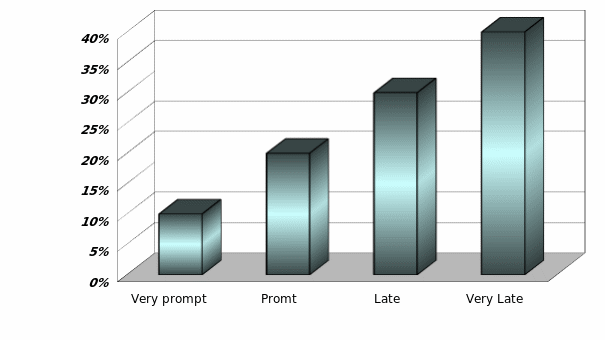
Result: Most of the respondents have selected last option (very late), which demonstrates that customers never get feedback on time from E&PM. As a result, SABIC should more concentrate on the main objective of shared service unit in order to develop its quickness of service delivery.
Respondents view about the main problem of software in E&PM
The researcher has designed this question as secondary resources demonstrate that integration of software is a challenging job for SABIC. According to the survey, 15 customers or 30% customers said that integration software for different geographical locations is the main problem in E&PM, 20% customers said the software are out dated, only 10% customer chosen limited resources and 40% customers selected low quality option.
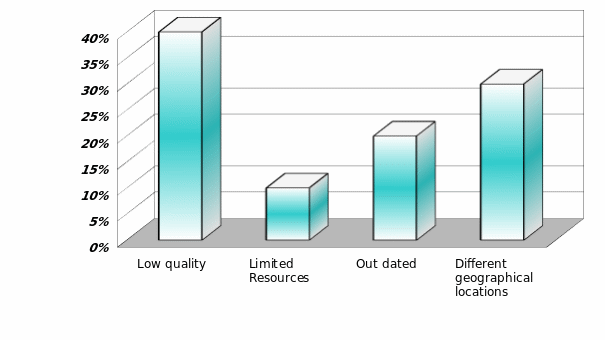
Result: According to the view of respondents, it can be said that SABIC should introduce high quality software for technological invention.
Respondents opinion regarding the most important factor to improve shared service
It is an interesting question to find out the most significant factor to advance shared services. It is an interesting question to find out the most significant factor to advance shared services. However, among 30 respondents, 12 people argued that SABIC should appoint new employees, 12 respondents said that it should offer high quality software, and only six respondents mentioned that it has enough qualified employees who need training.
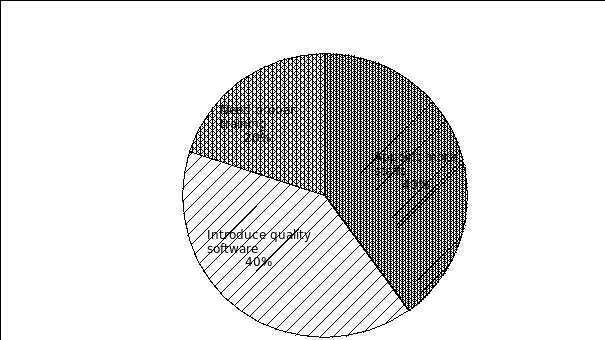
Result: From this answer, it can say that SABIC should recruit additional employees, and it need to introduce high quality software for the development of E&PM.
Respondents view about worse sector
This question is one of the most significant questions to measure performance satisfaction and identify the weakest sector of the Shared service of SABIC. However, figure 22 demonstrates that among 24 respondents, around 50% of total respondents said that they are not very satisfied with complaint resolution process, and 25% respondents are not happy with service delivery system. At the same time, 10% respondents ticked on service request, post service support gradually, but only 5% participants selected qualification and attitude –
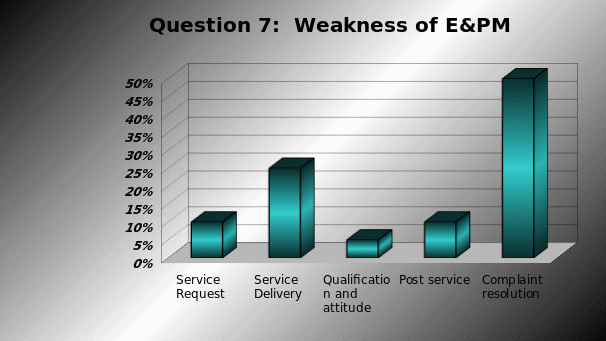
Result: As 50% of total respondents said that they are unsatisfied with complaint resolution, this sector can be treated as one of the weakest point of E&PM. In addition, this paper will recommend that SABIC need to improve complaint resolution system immediately by applying advance technology properly in order to develop share service practice. However, the answer of following question briefly explains the reason to consider complaint resolution process is the weakest system of E&PM to respondents.
Descriptive answer of question no seven
The respondents who choose option five of the previous question mainly considered proposed solution and resolution time factors. Due to queue of survey request from the affiliate’s members, it becomes hard for the shared service department to propose solution on time. In this context, most of the senior employees, leaders, management, and some junior employees of SABIC dissatisfied with the E&PM department. They also added that integration of information technology is not a new concept for SABIC, but arrangement of proper implementation also important factor for the development of shared service. On the other hand, they are not satisfied with the service delivery system of E&PM department because the cost is not effective for the affiliates. They also address that to increase the level of sophistication and competitive dynamics, it should develop web-based portal, which proves its multi- performance to administer easily their mail accounts and customer care data via SABIC website. However, the following discussion chapter would broadly analysis the weakness of E&PM of SABIC.
Strength of E&PM considering performance satisfaction
It was a straightforward question and 60% respondents said that they are very satisfied with qualification and attitude of E&PM, 10% selected option one and two, 15% supported post services and only 5% considered option three.
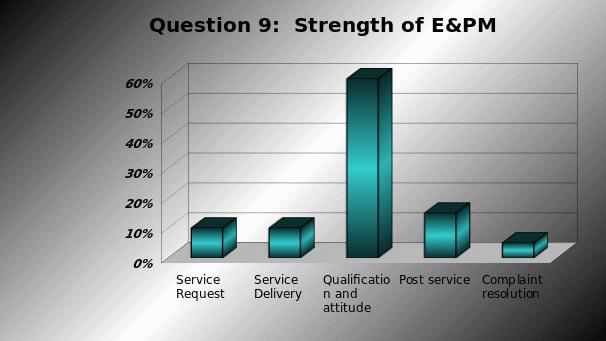
Result: From the answer of the respondents, it can be found that most of the customers are highly satisfied with corporation, innovation, and communication skills as qualifications and attitude issue has the highest End-User satisfaction rating within Engineering Services.
Descriptive answer of question no nine
According to the view of the respondents, remarkable financial strengths, E&PM serve value added services for the customers, satisfactory production degree, and new strategy of this department. However, the chapter five of this dissertation would broadly discuss the strong point of E&PM of SABIC.
A. The cost estimation for the project by the E&PM is problematic for its affiliates
The researcher has designed this question to get a clear view of the employees of E&PM, as the company is well develop with technological equipment, but still there are many objections against shared service of E&PM. However, 60% of respondents selected strongly agreed with the statement, 10% chosen agree, 15% simply disagreed, and 10% strongly disagreed, and only 5% respondents were neutral.

Result: The selected affiliate’s members of SABIC mentioned that the cost estimation is a significant document, which helps in decision-making and cost controlling procedures to settle on the amount in monetary terms essential to undertake an action. Most of the time E&PM of SABIC provides the cost estimation document without considering the pricing policy of the company, as a result, final cost calculation conflicts with the preliminary (Conceptual) estimate.
B. SABIC should develop the Quality Management Area of E&PM –
The survey report shows that among 30 respondents, highest 75% affiliates member of SABIC selected strongly agree option and 15% simply chosen agree option and rest of them select disagree. However, the following figure demonstrates that no one was neutral in this question or strongly disagreed with the statement –
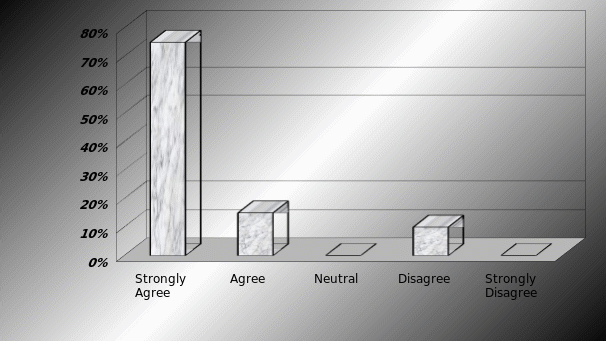
Result: In order to answer this question, the respondents consider quality policy of SABIC, designer qualification, employee training and education, design planning, inputs, process, interface control and many other related issues. From the survey results, it is clear that the affiliates of SABIC are not satisfied with existing quality management issue and they recommend that SABIC should change quality control policy in order to get proper outcomes from this sector. SABIC should concentrate more on design maintainability, performance quality audit, and working relationship issues.
C. Are you support that the staff of this department are not enough competent –
From the response of this question, the researcher of this paper find outs that 25% customers selected strongly agree, 25% respondent agreed, 10% were disagree, and 5% were strongly disagree with the statement and 5% respondents have no opinion.

Result: The survey result shows that 75% of the total respondents think that the employees of this department are not competent enough to provide shared services, as they cannot use the resources accurately. In addition, they added that SABIC should appoint experienced and trained employees for the progress of shared service sector. As most of the respondents are highly dissatisfied with the employees, SABIC should more concentrate on the development of its human resources. According to the annual report of SABIC (2009), it also understands that investing in the enlargement of such an imperative resource is a key issue in obtaining the competitive advantage. However, the respondents further added that new employees should have 10 years experience in industrial project management sector or petrochemical industry, leadership qualities, analytical ability, decision-making power, computer skills, familiarity of the application of latest software.
D. Affiliates should take help of Local Engineering Firms for project –
According to the respondents view, more that 50% of the respondents were strongly disagree, 25% participants disagreed, 20% respondents were neutral, and 5% participants agreed with this statement.
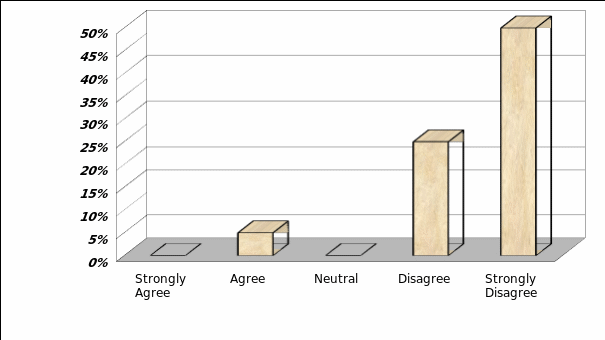
Result: from the answer of the respondent, it is clear that substitute local engineering companies cannot solve the problem of SABIC. They also argued that it would not be cost effective solution to take help from other local companies as E&PM SABIC has all the facilities for the projects. On the other hand, there are 1,400 engineering licensed companies in the KSA and only 5% respondent deal with industrial projects by joint venturing with the foreign engineering firms and getting technological and economic help from both public and private industrial segments. In addition, they mentioned that local firms have limited ability to deal with large industrial projects because of lack of experience and financial support.
E. Please include your other recommendation, comment, or opinion –
Engineering services pricing is complicated work while proficiency, inventiveness and quality are hard to quantify. Most of the answers has considered carefully and removed errors and integrated in the recommendation part
Discussion
Measures of Shared Services Practice at SABIC
It has already quoted that SABIC has adopted the SSO during 2003. Aim of this specialization has to supply of complementary services toward SABIC and it’s affiliates so that with the aid of SSO, SABIC would have achieved optimal efficiency standard, strategic objectives, effectively and efficiently utilization of existing resources. Alternatively, the SSO has formed to providing unsurpassed utilization of the SABIC resources. Moreover, make available centralize managerial services to the entire SABIC affiliates. Major seven areas of the SSO have plotted below in order. (Al-Jaroudi, 2007).
- Information and Technology45
- Accounting
- Employment or recruitment services
- General or regular services
- Supply Management and Procurement46
- Planning and controlling
- E&PM
Though this paper has required focusing on both SSO and the E&PM of SABIC, it has to be referenced that the E&PM is a crucial branch of the SSO as above. Consequence of this, besides SSO the E&PM has also significantly focused in this paper as well. As an operation branch of the SSO, E&PM has executed and provided superior value of the project management, economical process engineering, project assistant, as well as proficient engineering services to entire SABIC affiliates. The E&PM of the SSO has composed via four broader divisions. They are the engineering department, SPM, DMD and the engineering department.
Critical success factors of the SSO
Based on Washington State (2009) SABIC case study has identified following significant dynamics during shared services practice.
- SABIC has officially adopted as well as executed governance structure during shared services practice.
- Governing board of the SSO has formed through following stages.
- Firstly, continuous revising or development as well as approved of the recommended strategies so that the SSO would have more concerned on SABIC utilities.
- Secondly, SABIC business decisions have to make based on volume of SABIC utility assessed through SSO, business statistics as well as the adoption percentage.
- Thirdly, SABIC has encouraged both domestic and international affiliates’ commitments while the SSO would be executed;
- Fourthly, adopt user-friendly supporting tools for consumers in addition to affiliate’s satisfaction.
- An experienced SSO leader has the efficiency designing, implementing SSO procedures so that SABIC would have economically grasped expected outcomes in practice. Moreover, successful business transition would also be possible.
- Lack of principle resources as well as skills would be complicated transformation of the SSO practices. For the future amendment as well as effective management training, development and strategy formulation, satisfactory level of managerial skill has essentially needed.
- For the successful implementation of the SS practices, available guideline has to be existed in the project management supporting areas.
- For every SS reviewing, financial support has to be introduced and approved so that SABIC would be able to starting new services for their existing consumers.
Anticipated business results through practicing the SSO
In case of SABIC petroleum business practices, the SSO has the efficiency to provide multiple merits as below. (Washington State, 2009)
- Including IT services, cost management, and efforts would have easily reduced in the SABIC support services.
- Multiple values would have grasped in the support service line.
- During implementation of the information tools, the staffing line would be performed better than before.
- Investment value, data processing, record of agency resources could be free of duplication.
- Market risks would be reduced.
- Decrease lead-time as well as entrance into the market.
- Consumers’ complain would be resolved earlier than before.
Performance evaluation of shared services practice
In order to assess performance efficiency of the SSO, the design process has to apprise at first and during this course, strengths and weaknesses would have assembled. Three different performance evaluation levels have put down below (Al-Jaroudi, 2007).
I) Performance attributes ranking: during July 2003, the WMU47 had arranged a workshop in order to appraise performance efficiency of the engineering performance procedure. The key engineering disciplines have been represented by 14 faculty members as well as administrators of civil, mechanical, chemical, and electrical. In this workshop, non-technical disciplines’ representatives have also participated. Based on team behaviors, the team has spotted ten attributes or features for which a design would be succeeded. Additionally, the workshop has appointed a successful engineer to exhibit or promote this model. According to the significance in practice, this attributes ranking module has ranked. For example, first feature of this ranking would have got most importance and sequentially value of the attributes efficiency has been reducing in a descending order as showed in following table.
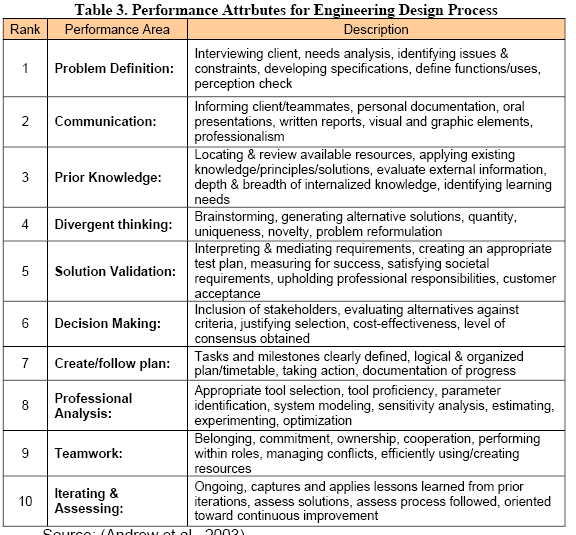
II) Performance chart form: performance chart form is the second phase of the performance attributes ranking where this chart form has described different five skill levels like the proficient designers, the superior designers, trainee designers, interns, as well as trainee and so on. Under this approach, individually each class of designer skills has assigned to attend behavior matching or a predictable act test. An evaluator has matched the level of skill for every task of the designers in order to describe appropriate team behavior or identification of skills level in practice. This level has few demerits due to complex application of vocabulary during harmonizing of the team performance behavior. Table of the performance chart form has presented below.
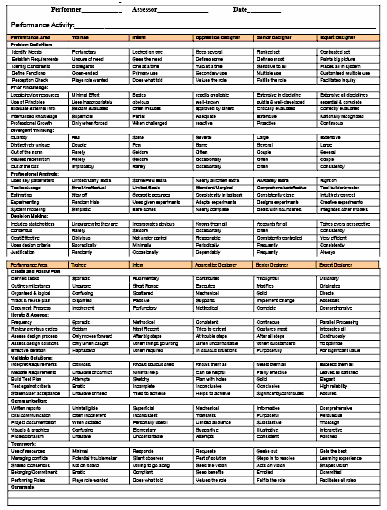
III) Weighted evaluation form: under the performance areas based on significances, weighted factors have identified for each task or team behavior. The evaluator or the surveyor has assigned to appraise every team behavior ranging from one to five and multiplied them by the weighted factor. Ultimate score has to be used to highlight the skill level of the individual designer or the design team. In this level, score range has pointed from 200 to 1000 points and for every 200 points, skill level would have denoted as a suitable level. Considering all of above, the weighted evaluation form has carried a few demerits because changing of evaluator would have a cause to fluctuate weighted factors scoring.
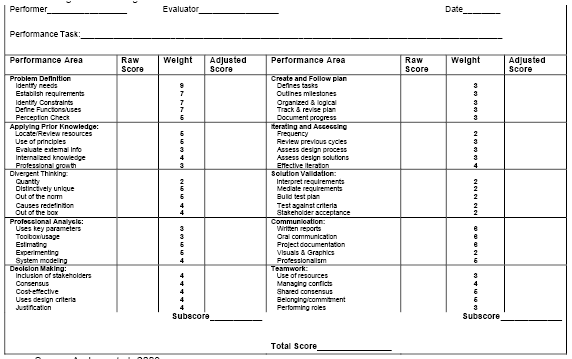
Prospects attained by practicing SSO
Washington State (2009) pointed out that following prospects achieved by practicing SSO.
- Continuation of service regularity would be achieved.
- Resources would be utilized economically.
- SABIC would be enjoyed economies of scale grater than before.
- For the SSO practice, an agency would be considered a candidate if the agency has required data, necessary competencies, applicable processes to duplicate or efficiency to meet other agencies demand.
E&PM strengths and weaknesses
Strengths of the E&PM
Followings are the most important strengths of the E&PM at SABIC.
- Petrochemical heavyweight at SABIC: it has already quoted that the Saudi government has owed 70% of SABIC ownership as a result SABIC has enjoyed remarkable financial strengths as well as marketing success. On the other hand, adoption and application of the E&PM has opened the door of economics of scale. Moreover, enlargement of the petrochemical fields along with the E&PM application has also made available the economies of scope. For example, growth rate and profit margin of SABIC continued flawlessly from 2005 (GCC Equality Report, 2007).
- Value added service delivering: operating areas of the SABIC E&PM has served value added services those have a significant impact on organization during project execution. For example, both staffing as well as de-staffing has reduced. Following are the few of E&PM value added service features. (Almubadal & Al-zahrani, 2005)
- Processing, standardization, and organism have uniformed for instance, ITB formats, awarding, inspection of contract progress and so on;
- An economical practice of capital has reduced 10%-anticipated cost of capital for SABIC medium size projects. On the other side, practice of uniformed process has provided cost optimization advantages
- An enhanced growth has appraised in the area of working environment safety with the environmental concerns. For example, reliable safety protection and prevention tools, concern on entire global health issues, and environmental recycling.
3. Affiliates satisfaction: Hypothetically, quality has defined that features that satisfied affiliates requirements in accordance with the codes and standards of an organization. The E&PM at SABIC has dramatically persuaded their major affiliates throughout their cost effective design, design quality, codes and standards of the contract, constructability, performance evaluation and project execution process. In following table affiliates’ satisfaction result has described. (Al-Jaroudi, 2007)
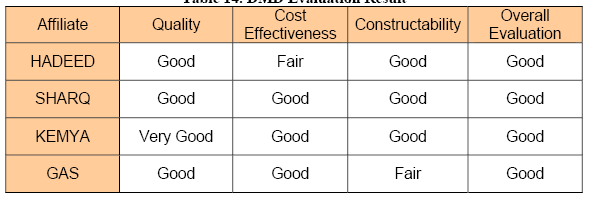
4. Satisfactory production degree: SABIC industrial conglomerate has merged with 21 tremendous manufacturing companies. Most of them among these major portions have involved in joint venture operation internationally. In terms of production scale during 2010, within the 30th year of SABIC formation it has earned 75 million MT. (Al-Abdulgader, 2010)

5) Decrease of workforce demand: SABIC is a major employer, with over 16,000 multinational employees spread worldwide. However, after adoption of the E&PM, workforce requirement of SABIC has dramatically reduced showed in following diagram.
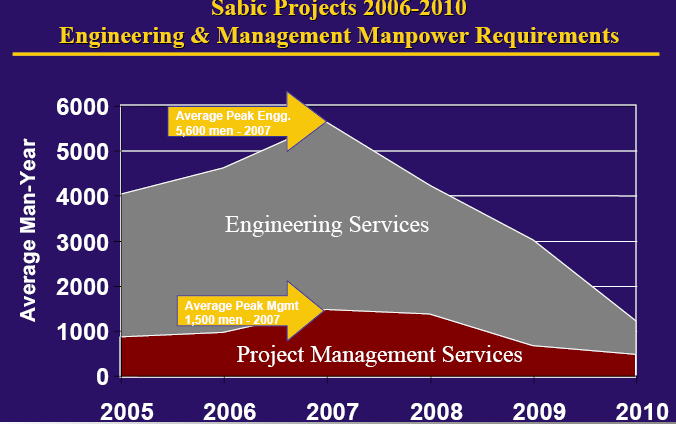
Cost Breakdown
Due to a suitable strategic plan as well as vision, SABIC management has occupied the title of international largest petrochemical company though a stiff competition has existed in this market. One of the most significant strategies of SABIC has taken in their account accurate costs management as following table.

Weaknesses of the E&PM
On behalf of Al Kharboush (2010), following five obstacles are the key weaknesses in the international petrochemical industry like SABIC
- Enlarge global competition: Globalization culture and vast usage of the electronic communication tools like Internet has reduced national boundaries as well as rigid business competitions though trade scope has increased. Facts of the rigid international competition have motion through several forces. Amongst them competitive price value has ranked first and sequentially, superior quality products and services strengthen this rigid stag. These forces have created problem on the pillar of its current profitability and retain the consumer growth. On the other hand, recent IT services information and the global market have more transparent than before, as a result, data entrance and sharing have become more complex. Moreover, in the petrochemical companies like SABIC require to pay more attention on the area of the manufacturing competitiveness factors.
- Rapid changes of environmental issues in the energy sector: Natural gas and the crude oil have the most significant and major resource in the energy sector. In this case, there have exists great uncertainty demand and supply volume during the last decade. For instance, within the last five year price of the crude prices has fallen from US$ 80 Bbl to US$ 60 Bbl, which has left an intense challenge to the petrochemical industries like SABIC. This imbalance scenario has powerfully altered their cost of production as well as the fuel stocks. In recent times, the ExxonMobil Corporation has published durable energy circumstances for the year 2030. In that publication, they have served the baseline scenario of fuel supply and demand balancing additionally population growth in Asia, Africa along with Latin America. Conclusion of the publication identified that in 2030, population would be 8 billion since yearly the global population growth has been 1% now. On the other hand, yearly current oil demand has about 1.4% and hence it would have turned into 120 million B/D in 2030. Ultimately, the ExxonMobil publication has left a question before end of the report “How would the demand of oil be met?”
- Geo-political subjects: Geo-political subjects have discovered on several significant issues, which have radically influences the balance between oil demand and supply, financial amplification, international trading, global health issues, international dealings and so on. Moreover, a few concerns have developed in producing oil in the future, which has targeted major oil producing zone of the world. Here, it has to be pointed out that geopolitical issues would be conceived as Shell practiced in these zones. On the other side, unfortunately, existence of skills could not be resolve ancient clashes, so, the geopolitical issues have always kept far from the credible solutions. Lacks of aware to distributing the geopolitical disturbances have existed as a great threat to the global petrochemical industries now as well as in the future. Sequentially, this crisis would have affected the regular consumers along with the business alliances in both domestic and abroad. Moreover, in future fresh geopolitical issues would be integrated along with consumer’s destiny. Success of these industries has mostly depended on the efficiency to steering a lucid roadway towards the global disagreements.
- Imbalanced trade-off between economic growth and cyclicality: In 2006, a few global business researchers have tried to search imperative business issues in the global economy for the next decade. Major portion of them have replied similar thought and focused more on two matters, firstly, how the co-alliance policy of the USA has utilized as well as how overseas loans will be disrupted? Secondly, how would the production growth of India and China be transformed the global economic structure? The complete analysis of these issues would be made the story of this decade to generate new dimension of economy. The economist’s has alarmed about the weakening of the US$ which has moisture through large number of US existing imbalanced account as well as insipid domestic savings rates. Sequence of these interest rates has increased along with the global financial tenderness. To get free from the current economic unsteadiness chief exporters as well as the customers have to co-dependent each other through a uniform standards quo. The Wachovia Bank has appraised that within the next 15 years 40% global economic escalation would be arrived from the emergent nations. Currently, supplies of workforce, manufacturing equipment have appeared mostly from Brazil, China, and India. Scope of excess on top of capacity as well as highly competitive employment costs has greatly enthused trading internationally besides reducing the global inflation rate. The international trade as well as the global financial movements has managed and controlled the petrochemical production development along with turn down.
- Costly projects as well as lengthy lead-times: Another key issue – the EPC has the efficiency to expand new projects. Alternatively, it has an enormous entrance skill during project cost management that could be influenced project starting time, expansion of the lead-times would be bruised the consumers emotion. Moreover, the EPCs have got over volume through expansion of new projects as well as longer lead-times.
Conclusion
Recommendations
- The E&PM department of SABIC should recruit more experienced engineers and other competent employees in order to provide fast and quality services for different affiliates of Jubail;
- According to the annual report 2009 of SABIC, the production cost is increasing due to high rate of the gas price. The engineers of this department should take immediate action to apply cost effective strategies;
- SABIC should properly utilize the advantage of technology as the respondents of the survey were not satisfied with the e-commerce system of SABIC and they believed that the use of e-commerce in case of SABIC is limited in tracking product in transit, logistics operation, and shipment tracking. In addition, Design Management Department should introduce quality control system, for example, ISO 9001, (Quality management system requirement) to advance the quality of design for its affiliates;
- Moreover, it should extend or adopt more effective database system to collect and retrieve data about the clients since. As a result, it should take initiatives to make the availability of data every time when required since engineers face some technical problem in such cases.
- Al Jaroudi (2007) stated that DMD should include Constructability plan for every project to make sure the possibility of construction with optimum alteration in the existing facilities;
- To give instant feedback of the problems and enquiry of the affiliate members, the call centre of the SABIC should require having virtual and dynamic effect. As there are many dilemmas in CRM system, SABIC should open more call centre in Jubail and other industrial area to reduce the problem of the customers with proper solutions.
- SAP software helps the company to acquire a comprehensive and consistent view of every customer, so it should to resolve all problems related to SAP business process to evade the failure during transition time;
- The option process for requesting the services should simple for user;
- It should integrate other related software complaints management software, campaign management, after-sales service, and facilitate the sharing of knowledge and encourage collaboration system;
- Most of the respondents argued that, E&PM should increase share service and take appropriate measure by considering previous global financial crisis to expand the business by foreign direct investment;
- E&PM of SABIC should contemplate both on the End-User Satisfaction as well as engineering Services to recommend quality service;
- However, end user collaboration is the main constituent to offer admirable services;
- It is essential to mention that process engineer is very significant in process projects, so, DMD should have process engineers within the design team and not from affiliate employees;
- In addition, it should focus more on motivation of process engineer, internal meeting, audit reports, and team learning in order to coordinate them to work as family;
- Development of management and upgrading in network contents that involves infrastructural modification for latest items, especially for broadband, installation and proper management of e- components and cables while financial support is a major factor;
- Along with depending on internal technological team, SABIC should employee some external e- business experts since the industry has saturated by so many different expertise with more sophisticated e- knowledge like BT, Carphone Warehouse, O2 and others providing VOIP, IPTV and so on;
- SABIC should provide updates to the customers about their new cost effective strategy to minimize customer’s tension about their projects;
- As figure 12 shows that buyers like good quality products, the management team of SABIC should highlight on quality issues when contacting with customers;
- Some members complained that they couldn’t utilize the facilities of this department due to unnecessary delay to get feedback. However, they should understand that service provider requires sufficient time to plan and carry out the service;
- From the above discussion, it can be said that E&PM can be an effective weapon for the affiliates of SABIC to build and improve an excellent relationship with its customers;
- A variety of E&PM procedures and formats needed fine modification for getting better service quality;
- Management of E&PM of SABIC should arrange regular structured meetings with all related stakeholders in order to discuss operational and service issues;
- Moreover, SABIC should use faster level of SIs in each major aspect of operation along with taking of a scope of dynamic sales, fundamental integrated IT technology, and individual SI channel for sales force;
- Furthermore, SABIC should always apply supervision in self- judgment in terms of keeping flow of differential strategy, continuous development programs, analyzing the functions of major competitors in terms of e- business applicability, brand recognition for adding technological value and overall calculation for measuring risk and reward;
- To advance current position of the service, SABIC should develop the system to provide regular updates on the progress, and send newsletters;
- To obtain the maximum benefit of the service, End users should gather more information about the service range or offered services of engineering department.
However, SABIC lags behind of many international petroleum firms in the field of shared service delivery. Too many affiliates of SABIC hang about frustrated through using the shared services those maintain on compound forms, different offices, raising interviews, and several points of contact with the customer and vendors under the existing service providing arrangement. Not all the government agencies and affiliates of SABIC are using Information Technology to attach their operations, complains and communication to adapt their shared services to the affiliates. Thus, the shared service practice of SABIC needed to have further reformation with outlook to integrate more customer and affiliates in nears future and urged for an additional people-focused approach.
Being a sate owned petroleum firm, SABIC need to calls on the government to think about the opening of a regular public domain of shared service provider involving all governmental agencies, municipals, and citizens in a data center connecting a Central Public Sector Business Unit Model. However, the current practice of SABIC is under Public Sector Arms Length Body (ALB) and such transformation would deliver more cont saving for its service delivery.
The use of internet in KSA is in the first generation, but it is continuously becoming popular and turns as a common means for Saudi Arabians to contact with royal officials and this contact is mostly passive to getting information, filling forms and service delivery. At this stage, if the experience of SABIC integrated with the governmental service delivery by the Central Public Sector Business Unit Model, the future government will be capable to tap the ideas of citizens’ directly.
SABIC needed to conduct regular survey among its affiliates and customers of engineering and project management about their satisfaction level with the provided share services that would ask for employees, stakeholders, and citizens’ views on the quality of services as well as collect the ideas of improvement from the end users option. At the present form, the dilemma of customer queuing at service center has created customers dissatisfaction where SABIC would urge to assess this situation with network queuing model as well as application ofKPIs and Balanced Scorecard measures may contribute SABIC to overcome the challenges of measuring performance.
SABIC should argue the government to integrate the expertise of SABIC’s front-line employees of shared service delivery with the Saudi Public Service employees where both private and pubic sectors can bring further effectively while the government of KSA integrated IT just not only to position the citizens to the heart of shared services, but to allowing for service design.
Conclusion
The aim of shared service of SABIC was to develop the quality of corporate support services and provide additional support for outside suppliers and contractors. In addition, it wanted to expand complementary services between SABIC and its affiliates by integrating a new Global Enterprise System and implementing ERP/SAP technology at all affiliates. However, this dissertation has measured the design practice of Shared Services E&PM of SABIC by considering the effectiveness of this sector and performance satisfaction rate. From the outcome of primary data, it can conclude that Affiliates of SABIC are mostly satisfied with service of this department though they have some complain against E&PM of SABIC. For example, some of them were not happy with complaint resolution system, cost estimation, delay in handling some projects, difficulties with the SAP system and so on. However, E&PM of SABIC has huge opportunity to upgrade its service range by following recommendation of the affiliates of the company in case of complaint resolution, service request, service delivery, proper use of SAP, coordination between the customer and the service supplier, priority of the project, competent employees, and so on.
Reference List
- Aguirre, D. et al. (1998) Shared Service: Management Fad or Real Value?
- Al-Abdulgader, A. I. (2010) SABIC Current & Future Growth.
- Almubadal, T. S. & Al-Zahrani, S. M. (2005) Customer Satisfaction Survey for SABIC Engineering Services. Web.
- Al-Jaroudi, W. S. (2007) Design Practices in Petrochemical Firms in Saudi Arabia SABIC as Study Case. Web.
- Al Kharboush, M. (2010) Saudi Basic Industries Corporation (SABIC).
- Audit Office NSW. (2004) Shared Corporate Services: Realising the Benefits.
- Balsamo, S. & Marzolla, M. (2005) Performance Evaluation of UML Software Architectures with Multiclass Queueing Network Models. Web.
- Beaman, K. (2008) Global Shared Services: Expanding Your Reach and Presence Through Globalization.
- Bolch, G. et al. (2006) Queueing Networks and Markov Chains: Modeling and Performance Evaluation with Computer Science Applications. 2nd ed. New Jersey: Wiley-Interscience.
- Cabinet Office UK. (2008) Shared Services Guidance: Delivery Models.
- Chima, C. M. (2007), Supply-Chain Management Issues In The Oil And Gas Industry. Journal of Business & Economics Research, Vol5(6).
- Davenport, T. H., Harris, J. G., and Cantrell, S. (2004) Enterprise systems and ongoing process change. Business Process Management Journal, 10(1), 16-26.
- Duncan, W. R. (1996) A Guide to The Project Management Body of Knowledge.
- GCC Equality Report. (2007) Saudi Basic Industries Corporation (SABIC).
- HSBC. (2007) Global Research: Saudi Basic Industries Co.
- Hussain, R. Assavapokee, T. & Khumawala, B. (2006) Supply Chain Management in the Petroleum Industry: Challenges and Opportunities. International Journal of Global Logistics & Supply Chain Management, Vol. 1, No. 2.
- IBM Corporation. (2006) Shared Services Driving UK public sector transformation and revitalization.
- Intellect UK. (2007) Implementing Shared Corporate Services in the Public Sector.
- John, L. K. (2007) Performance Evaluation: Techniques, Tools, and Benchmarks. Web.
- KPMG. (2008) Financial Shared Service: Delivering the Promise.
- Malhotra, N. K. (2009) Marketing Research- An Applied Orientation. 5th ed. Prentice-Hall of India Private Limited.
- Marshall, C. & Rossman, G., (1999) Designing qualitative research. 3rd ed. Thousand Oaks – CA: Sage.
- Mechling, J. (2004) Shared Corporate Services: Realising The Benefits Guidance On Better Practice.
- Muras, A.D., Calhoun, D. D. & Stripling, W. S. (2000) The ABC’s of Activity Based Management (ABM) in the Petroleum Industry. Petroleum Accounting and Financial Management Journal.
- NECE. (2006) Guidance for collaborative options evaluation and appraisal of service delivery models.
- PMBOK. (2000) Project Management Body of Knowledge.
- Ramady, M. A. (2006). Mega Refinery Projects at Jubail and Yanbu Open Door for SMEs.
- Roberts, B. (2009) HR Shared Services: A Fresh Look. Business Week Research Services.
- SAP AG. (2004) Shared Services: SAP White Paper.
- Saunders, M., Thornhill, A. & Lewis., P. (2006) Research Methods for Business Students. 4th ed. London: FT Prentice Hall.
- Schulman, D. S. (1999) Shared Services: Adding Value to the Business Units. 1st ed. New York: John Wiley & Sons, Inc.
- Schulz, V. (2009) Definition and Classification of IT-Shared-Service-Center.
- Sekaran, U. (2006) Research Method for Business. 4th ed. John Wiley & Sons, Inc.
- Selden, S. C. (2010) Human Capital Shared Services: Cutting Costs and Strengthening State Operations. Web.
- Suri, R. et al (2007) Approximate Mean Value Analysis for Closed Queuing Networks with Multiple-Server Stations.
- Wang, H. (2007) Performance Analysis for Shared Services. Communications of the IIMA. Volume 7 Issue 2.
- Washington State. (2009) Shared Services Model.
- Zikmund, W. M. (2006) Business Research Methods. 7th ed. Orlando: Harcourt Publishers.
Footnotes
- Engineering and Project Management
- Shared Services Organization
- Engineering and Project Management Department
- ABM
- ABC
- Transfer of Undertakings (Protection of Employment)
- Non Departmental Public Body
- Customer Relationship Management
- Central Purchasing Body
- Customer Relationship Management
- Detail Design Packages
- Front End Engineering Package
- Detail Design Package
- Front End Engineering Design
- Conceptual Design Packages
- Site Project Engineer
- Lead Project Engineer
- Technical Assurance Team
- Process Hazardous Analysis
- Hazard and Operability Study
- SPM
- Material Take Off
- Engineering, Procurement and Construction
- LSTK
- Piping and Instrumentation Diagram
- Process Flow Diagram
- Engineering Drawing Management System
- DMD
- SPM
- Detailed Designed
- Supplied Management Organization
- Project Material Management
- Key Performance Indicators
- First In First Out
- Processor Sharing
- Last In First Out
- Mean Value Analysis
- Mean Value
- Approximate Mean Value Analysis
- Schweitzer-Bard
- Project Management Services
- Invitation To Bit
- Standard Assessment Procedure
- Computer assisted telephone interviewing
- IT
- SPM
- Western Michigan University